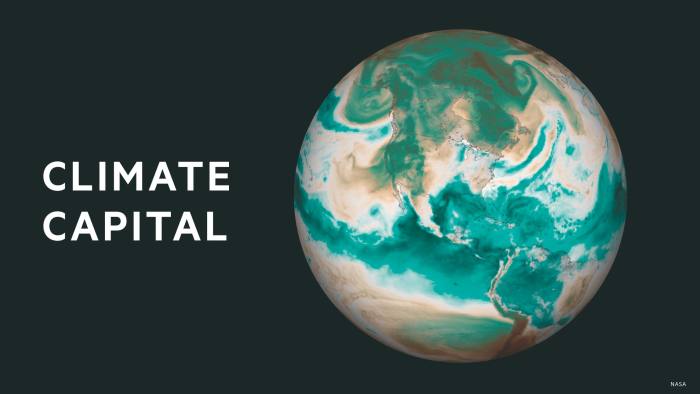‘A super-flood to beat all’: monsoon disaster piles misery on Pakistan
Pakistan’s prime minister Shehbaz Sharif has warned of a “humongous challenge” ahead following catastrophic floods in the country that have coincided with an acute financial crisis and a deepening political conflict between the government and former leader Imran Khan.
The disaster during a monsoon season that came after a spring of baking temperatures has made Pakistan a case study among countries vulnerable to climate change that are also battling interlinked humanitarian, economic and political crises.
After flood waters swept away settlements, pooled in low-lying areas and caused the country’s largest lake to overflow on Wednesday, officials said about 1,400 people had been killed and as many as 40mn, or about a fifth of the population, had been displaced. A third of the country is under water and more than half of its 160 districts have been declared “calamity hit”.
Sherry Rehman, Pakistan’s climate change minister, has described the disaster as “the climate catastrophe of the decade” and “a super-flood to beat all”.
The government estimates at least $10bn of destruction has been caused, with analysts saying the damage appeared to be worse than in 2010, when floods across almost one-fifth of Pakistan killed nearly 2,000 people.
UN secretary-general António Guterres is due to tour some of the worst-hit areas on Friday, in a visit that Pakistan’s leaders hope to leverage to persuade foreign donors to provide emergency funds.
“This natural disaster, this calamity, should elicit an international response — which it has not elicited so far,” said Shahnaz Wazir Ali, a former MP and minister of social welfare. “If there isn’t a reasonably substantial rescue programme, then it will be a complete disaster,” she added. “There could be food riots, instability.”

Prices are already soaring for food and other essentials. “Onions and tomatoes are twice or four times as expensive as just a month ago, and we haven’t had fruit for months,” said Dilawar Khan, a father of seven who lives with his wife and parents in a poor area of Islamabad. “We now even have to conserve on tea.”
The disaster comes in a year when supply-chain disruptions and inflation caused by Covid-19 and Russia’s invasion of Ukraine had already pushed Islamabad into a liquidity crisis that raised the spectre of a debt default. This was averted last month when Pakistan secured $1.1bn of funding from the IMF, as well as loan and investment pledges from Saudi Arabia, the United Arab Emirates and others.
Analysts have warned that unless Pakistan’s ruling elite and international donors respond urgently, the crisis could fuel political unrest and militancy in a country that has long struggled to contain both.
“As the calamity hits parts of the countryside, you will see greater rural-to-urban migration,” said Sakib Sherani of Macro Economic Insights, a research firm in Islamabad. “Increased food insecurity will contribute towards growing desperation.”
Pakistani officials have portrayed their country as a victim of climate change fuelled primarily by the rich world’s carbon emissions, but others say the country’s leaders have also done too little to bolster defences.

Shehryar Fazli, a political analyst and consultant based in Islamabad, said Pakistan had “not spent the time learning from the experience” of the 2010 floods, nor done enough to improve infrastructure and the preparedness of institutions, or to mitigate environmental risks such as inadequate soil resilience that were now disproportionately hitting Pakistan’s poor.
“While these horrors are upon us, the politicians still appear to be outbidding each other on who is more loyal to the military,” he said. “Imran Khan is holding rallies that have nothing to do with the humanitarian crisis threatening the population, and everything to do with the power struggle.”
Khan, who was ousted from power in April, has been pushing for early elections after his party won a series of local polls on a tide of populist anger.
As part of the IMF deal, Pakistan reluctantly accepted unpopular steps such as raising electricity and gas tariffs and almost doubling the price of petrol. The agreement allowed the country to avert default, but officials and analysts say targets it set are at risk of being missed and that they are revising their forecasts.
Climate Capital

Where climate change meets business, markets and politics. Explore the FT’s coverage here.
Are you curious about the FT’s environmental sustainability commitments? Find out more about our science-based targets here
“Looking at 2010-11 as a template, growth in the next few years could be a few percentage points lower, given damage to infrastructure, agricultural production and public services,” said Krisjanis Krustins, a director with Fitch Ratings’ sovereign ratings team.
“The fiscal deficit is likely to be a few percentage points wider given the hit to government revenue and increased spending needs,” Krustins said, although he added that these were “very initial assessments” and the situation was “still highly uncertain”.
Pakistan’s government has cut its expected annual growth rate for 2023 to 2.3 per cent, or less than half the previous target.
“Either Pakistan will have to renegotiate the targets, or the IMF will have to give waivers on some performance criteria,” said Muhammad Suhail, head of Karachi-based Topline Securities, an investment group. “In their present form, the IMF targets will be difficult to achieve.”